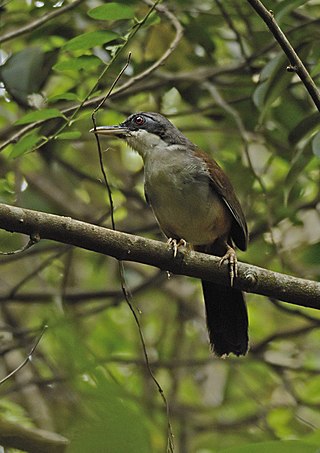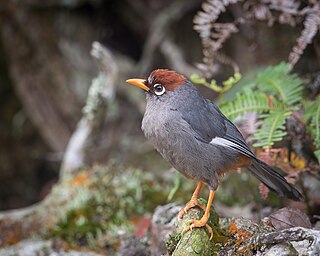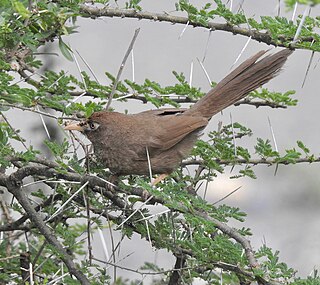
The orange-billed babbler, also known as Ceylon rufous babbler or Sri Lankan rufous babbler, is a member of the family Leiothrichidae.

The yellow-billed babbler is a member of the family Leiothrichidae endemic to southern India and Sri Lanka. The yellow-billed babbler is a common resident breeding bird in Sri Lanka and southern India. Its habitat is scrub, cultivation and garden land. This species, like most babblers, is not migratory, and has short rounded wings and a weak flight and is usually seen calling and foraging in groups. It is often mistaken for the jungle babbler, whose range overlaps in parts of southern India, although it has a distinctive call and tends to be found in more vegetated habitats. Its name is also confused with Turdoides leucocephala, which is also known as white-headed babbler.

The white-crested laughingthrush is a member of the family Leiothrichidae. It is a highly social and vocal bird found in forest and scrub from the Himalayan foothills to Southeast Asia.

The white-throated laughingthrush is a species of passerine bird in the family Leiothrichidae. It is found mainly in the northern regions of the Indian subcontinent, primarily the Himalayas, and some adjoining and disjunct areas. It ranges across Afghanistan, Bhutan, India, Myanmar, Nepal, Tibet and Vietnam. Its natural habitat is subtropical or tropical moist montane forests.

The black-throated laughingthrush is a species of bird in the family Leiothrichidae. It is found in Cambodia, China, Laos, Myanmar, Thailand, and Vietnam. It occurs as an introduced species in Hong Kong. Based on a combination of strong morphological and genetic evidence, the subspecies on Hainan Island is treated as a distinct species by some authors, Swinhoe's laughingthrush.

The moustached laughingthrush is a species of passerine bird in the family Leiothrichidae. It is found in China, India, and Myanmar where its natural habitat is subtropical or tropical moist montane forests.

The Wayanad laughingthrush is a species of laughingthrush in the family Leiothrichidae. It is endemic to the Western Ghats south of Goa in India. These laughingthrushes move in groups in dense forests, producing loud calls but tend to be hard to spot in the undergrowth. They have brown upperparts, a white throat, a broad black mask through the eye and a heavy bill with pale yellow on the lower mandible. Despite the name, derived from the Wayanad region, this species has a wider range than the four other south Indian species of laughingthrush that are restricted to the higher elevation hills.

The rufous-vented laughingthrush is a species of bird in the family Leiothrichidae. It is found in Bangladesh, Bhutan, India, Laos, Myanmar, and Vietnam. Its natural habitats are subtropical or tropical moist lowland forest and subtropical or tropical moist montane forest.
The chestnut-eared laughingthrush is a species of bird in the family Leiothrichidae. It is found in Vietnam and possibly Laos.

The chestnut-capped laughingthrush, also known as the spectacled laughingthrush, is a species of bird in the family Leiothrichidae. It is found in Sumatra (Indonesia) and the Thai-Malay Peninsula. Its natural habitats are subtropical or tropical moist lowland forests and subtropical or tropical moist montane forests. The chestnut-hooded laughingthrush was previously considered a subspecies.
The chestnut-backed laughingthrush is a species of bird in the family Leiothrichidae. It is found in Northeast India and northern Myanmar. This species inhabits secondary growth, thickets, tall grasslands with scattered shrubs or dense bushes in stony scrub-covered ravines and hills, from the lowlands up to around 900 metres (3,000 ft). It is threatened by habitat loss.

The spotted laughingthrush is a bird species in the family Leiothrichidae. It is found in Bhutan, China, India, Myanmar, and Nepal. Its natural habitat is subtropical or tropical moist montane forests.

The rufous-necked laughingthrush is a bird species in the laughingthrush family, Leiothrichidae. It is found in Bangladesh, Bhutan, China, India, Myanmar and Nepal, where its natural habitats are subtropical or tropical moist lowland forest and subtropical or tropical moist montane forest. Little study was done on this species due to its abundance and lack of interest in its conservation.

The striated laughingthrush is a passerine bird in the family Leiothrichidae. It was at one time placed in the genus Garrulax but following the publication of a comprehensive molecular phylogenetic study in 2018, it was moved to be the only species in the resurrected genus Grammatoptila.
The white-cheeked laughingthrush is a species of bird in the family Leiothrichidae. It is found in Cambodia, Laos and Vietnam. Its natural habitats are subtropical or tropical moist lowland forests and subtropical or tropical moist montane forests.

The scaly chatterer is a species of bird in the family Leiothrichidae. It is also known as the bare-eyed babbler. It is found in Ethiopia, Kenya, Somalia, and Tanzania. Its natural habitat is subtropical or tropical dry shrubland.

The slender-billed babbler is a species of bird in the family Leiothrichidae. It is found in Bangladesh, Nepal, Northeast India and possibly Myanmar. Its natural habitat is subtropical or tropical seasonally wet or flooded lowland grassland. It is threatened by habitat loss.

The rufous chatterer is a species of bird in the family Leiothrichidae. It is found in Ethiopia, Kenya, Somalia, Sudan, Tanzania, and Uganda. Its natural habitats are dry savanna and subtropical or tropical dry shrubland.

Argya is a genus of passerine birds in the laughingthrush family Leiothrichidae. The species are distributed across Africa and southern Asia and are typically fairly large, long-tailed birds that forage in noisy groups. Members of this genus were formerly placed in the genera Turdoides and Garrulax.

The laughingthrushes are a family, Leiothrichidae, of Old World passerine birds. The family contains 133 species which are divided into 16 genera. They are diverse in size and coloration. These are birds of tropical areas, with the greatest variety in Southeast Asia and the Indian subcontinent. The entire family used to be included in the Old World babbler family Timaliidae.



















